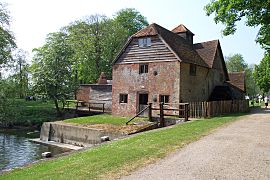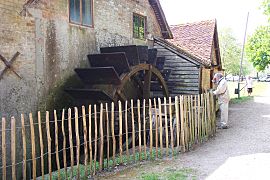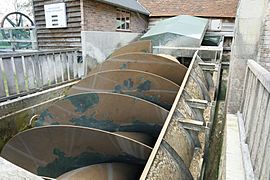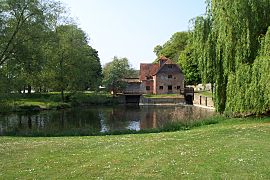Mapledurham Watermill facts for kids
Quick facts for kids Mapledurham Watermill |
|
|---|---|
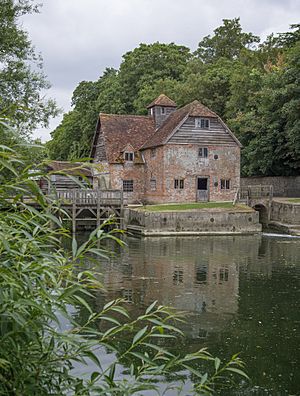 |
|
| Location | Mapledurham, Oxfordshire, England |
| Built | 15th to 19th century |
| Governing body | Mapledurham Estate |
|
Listed Building – Grade II*
|
|
| Official name: The Mill | |
| Designated | 24 October 1951 |
| Reference no. | 1059523 |
| Lua error in Module:Location_map at line 420: attempt to index field 'wikibase' (a nil value). | |
Mapledurham Watermill is a historic watermill in the civil parish of Mapledurham in the English county of Oxfordshire. It is driven by the head of water created by Mapledurham Lock and Weir, on the River Thames. The mill was built in the 15th century, and further extended in the 17th, 18th and 19th centuries. It is a Grade II* listed building and is preserved in an operational state.
The mill also houses a micro hydro-electric power station, using a 3.6-metre (12 ft) Archimedes' screw turbine to generate electricity for sale to the National Grid. The turbine produces some 83.3 Kilowatts, which is sufficient to power about 140 homes.
Contents
History
A mill was already present at Mapledurham at the time of the Domesday Book. The central section of the current mill building dates back to the 15th century. Originally the mill had a single water wheel on the river side of the building. The mill was increased in size in the 1670s, and a leat was constructed to drive a second water wheel on the village side. It is this second wheel which is still in use today.
In 1690, the mill was leased to James Web for the sum of £60 per year. Around 1700, he expanded the mill again to allow him to install the equipment to produce the refined flour that was becoming popular. His son Daniel Webb took over from him in 1726 at a rent of £100. In 1747, Thomas Atrum took over the mill at a rent of £150, which was raised to £205 in 1776. In 1777 a barn was added on the mill island, and a wharf built to allow the mill to supply flour to the London market by barge. However, by 1784 Thomas Atrum was bankrupt.
The mill continued to flourish, and as late as 1823 plans were drawn up to rebuild the mill in classical style. The advent of cheap imported flour from North America damaged the mill's prosperity, but it remained in use until just after the Second World War. On 24 October 1951, the watermill was designated as a Grade II* listed building. It was restored and brought back into use in 1980.
In 2011, work started on the installation of a new Archimedes' screw turbine on the river side of the watermill in order to generate electricity. This was built to provide power to Mapledurham House, and replaced a turbine installed in the 1920s that was no longer functional. At the time the turbine was inaugurated in 2012, it was the most powerful turbine on the River Thames, and the largest of its type in the country.
In 2022, the mill was vandalised with windows smashed and damage to wooden frames.
Admission and access
THE MILL IS CLOSED TO THE PUBLIC (AS OF TIME OF WRITING, DECEMBER 2023). IT IS OPEN FOR WEDDINGS AND GROUP TOURS ONLY.
The mill is located in the grounds of Mapledurham House, and like the house is open to visitors on weekend and bank holiday afternoons from April to September. The water mill is normally working on opening days, and visitors can visit both main floors of the mill, and see (and feel) its operation.
Admission is charged, and joint tickets are available that allow admission to both house and mill. Access is by car down the narrow and steep lane that is Mapledurham village's only road connection, or by a boat service that runs from Thameside Promenade in Reading on all opening days.
Gallery
See also
- List of watermills in the United Kingdom
- Museum of Oxford


